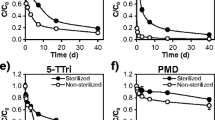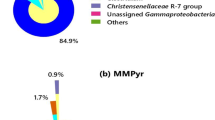Abstract
Highly substituted arenesulfonates are chemically stable compounds with a range of industrial applications, and they are widely regarded as being poorly degradable. We did enrichment cultures for bacteria able to utilise the sulfonate moiety of 14 compounds, and we obtained mixed cultures that were able to desulfonate each compound. The products formed were usually identified as the corresponding phenol, but because we could not obtain pure cultures, we followed up these findings with quantitative work in pure cultures of, e.g., Pseudomonas putida S-313, which generated the same phenols from the compounds studied. Many of these phenols are known to be biodegradable, or to be subject to binding to soil components. We thus presume that the capacity to degrade aromatic sulfonates extensively is widespread in the environment, even though the degradative capacity is spread over several organisms and conditions.
Similar content being viewed by others
Author information
Authors and Affiliations
Additional information
Received: 9 February 1999 / Revision received: 7 April 1999 / Accepted: 9 April 1999
Rights and permissions
About this article
Cite this article
Ruff, J., Hitzler, T., Rein, U. et al. Bioavailability of water-polluting sulfonoaromatic compounds. Appl Microbiol Biotechnol 52, 446–450 (1999). https://doi.org/10.1007/s002530051545
Issue Date:
DOI: https://doi.org/10.1007/s002530051545




